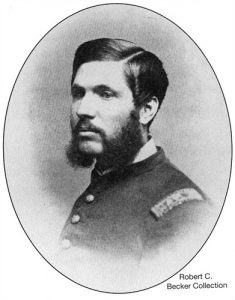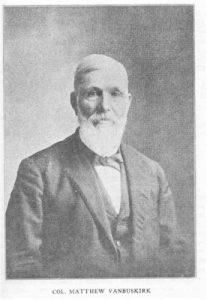It’s been a very long time since my last post, and even longer since my last Forgotten Cavalrymen profile. I’ve been working on the February 11, 1865 Battle of Aiken, South Carolina, which will spur several of these profiles. Here’s the first one, of Lt. Col. Matthew Van Buskirk of the 92nd Illinois Mounted Infantry.
Matthew Van Buskirk was born in Buckmantown, Clinton County, New York, on January 1, 1835. He was the son of Lorenzo Dow Van Buskirk and Louisa Van Buskirk, and had one brother, Albert, born March 20, 1841 (Albert Van Buskirk was killed in action at the Battle of Drury’s Bluff near Petersburg, Virginia on May 16, 1864). After completing his education, the young man relocated to Illinois in 1851, and was still living there with the coming of war in 1861.
He enlisted in the 92nd Illinois Volunteer Infantry, which was organized at Rockford, Illinois, on September 4, 1862, and was quickly elected captain of Company E. The 92nd Illinois consisted of five companies from Ogle County, three from Stephenson County, and two from Carroll County.The newly formed regiment left Rockford, 11 October 1862, with orders to report to Gen. Horatio G. Wright, in command of the defenses of Cincinnati, Ohio. The regiment was assigned to Gen. Absalom Baird’s Division of the Army of Kentucky. These men soon marched into the interior of Kentucky and was stationed at Mt. Sterling in October to guard against rebel cavalry raids during Braxton Bragg’s invasion of Kentucky. Later, it was assigned to Danville, Kentucky. On January 26, 1863, Baird’s division, including the 92nd Illinois, was transferred to the Army of the Cumberland. The division was assigned to serve in Franklin, Tennessee, and assisted in the pursuit of Maj. Gen. Earl Van Dorn’s Confederate cavalry raiders. They advanced to Murfreesboro,and occupied Shelbyville, Tennessee on June 27, 1863.
The 92nd Illinois Infantry converted to mounted infantry on July 22, 1863 and was rearmed with Spencer repeating rifles. It was then assigned to join Brigadier General John T. Wilder’s Lightning Brigade for the rest of Maj. Gen. William S. Rosecrans’ command of the Army of the Cumberland. During the early phases of what became the Chickamauga Campaign, with the Lightning Brigade leading Rosecrans’ advance, the 92nd Illinois crossed the mountains at Dechard, Tennessee, and took part in the movements opposite and above Chattanooga. The 92nd Illinois then crossed back over the mountains and joined Maj. Gen. George H. Thomas at Trenton, Alabama. On the morning of September 9, the Lightning Brigade led the Union advance to Chattanooga, helping to drive the Confederates from Point Lookout. The 92nd Illinois then entered Chattanooga, unfolding the Union banner on the Crutchfield House. They then pursued the retreating Confederates. Brig. Gen. Nathan Bedford Forrest’s Confederate cavalry attacked the Lightning Brigade near Ringgold, Georgia, inflicting significant casualties on the Federals. At Chickamauga, the 92nd Illinois supported Maj. Gen. Joseph J. Reynolds’ Division of Thomas’ 14th Corps.
In April, 1864, the 92nd was doing picket duty at Ringgold, Georgia. On May 7, 1864, the 92nd Illinois, which had now been converted to light cavalry and armed with cavalry weapons, began Sherman’s Atlanta Campaign as part of Brig. Gen. Judson Kilpatrick’s Third Cavalry Division. The 92nd Illinois participated in the Battle of Resaca, Kilpatrick’s failed raid around Atlanta, as well as the Battles of Bethesda, Fleet River Bridge, and Jonesboro, where the regiment lost one-fifth of the men engaged. The regiment moved from Mount Gilead Church, west of Atlanta, on October 1, and took an active part in the operations against Hood’s army, including taking heavy losses at Powder Springs. About this time, Van Buskirk was promoted to lieutenant colonel of the 92nd Illinois after Col. Smith D. Atkins was promoted to brigadier general of volunteers and assumed command of a Federal cavalry brigade.
The 92nd Illinois then participated in the various engagements and skirmishes in Sherman’s March to the Sea and then through the Carolinas Campaign of 1865. During its term of service, the 92nd Illinois participated in some forty battles and skirmishes. The regiment was mustered out at Concord, North Carolina, on June 21, 1865, and was then discharged at Chicago, Illinois, on July 10, 1865.
Van Buskirk “was popular with his soldiers and trusted by his superior officers,” noted one biographer. With the end of the war, he settled in Iowa Falls, Iowa, where he successfully operated a store selling boots, shoes and crockery and later dry goods and other items, growing his business into a general merchandising business. Later, he became a gentleman farmer. He married Nellie C. McGiven in 1866, and they had seven children together. Van Buskirk died on January 10, 1901 and was buried in Iowa City’s Union Cemetery. “He was a clear-brained, noble-minded man of action and his life record is worthy of emulation by the youth of this locality whose careers are yet matters for the future to determine,” declared his biographer.Here’s to forgotten cavalryman Matthew Van Buskirk, who performed his duty capably and with honor throughout the American Civil War.
Scridb filterNotice: Undefined index: id in /home/netscrib/public_html/civilwarcavalry/wp-content/themes/wittenberg/footer.php on line 8
Notice: Undefined index: id in /home/netscrib/public_html/civilwarcavalry/wp-content/themes/wittenberg/footer.php on line 8
Notice: Undefined index: std in /home/netscrib/public_html/civilwarcavalry/wp-content/themes/wittenberg/footer.php on line 8
Notice: Undefined index: id in /home/netscrib/public_html/civilwarcavalry/wp-content/themes/wittenberg/footer.php on line 8
Notice: Undefined index: id in /home/netscrib/public_html/civilwarcavalry/wp-content/themes/wittenberg/footer.php on line 8
Notice: Undefined index: std in /home/netscrib/public_html/civilwarcavalry/wp-content/themes/wittenberg/footer.php on line 8
Notice: Undefined index: id in /home/netscrib/public_html/civilwarcavalry/wp-content/themes/wittenberg/footer.php on line 8
Notice: Undefined index: id in /home/netscrib/public_html/civilwarcavalry/wp-content/themes/wittenberg/footer.php on line 8
Notice: Undefined index: std in /home/netscrib/public_html/civilwarcavalry/wp-content/themes/wittenberg/footer.php on line 8
Notice: Undefined index: id in /home/netscrib/public_html/civilwarcavalry/wp-content/themes/wittenberg/footer.php on line 8
Notice: Undefined index: id in /home/netscrib/public_html/civilwarcavalry/wp-content/themes/wittenberg/footer.php on line 8
Notice: Undefined index: std in /home/netscrib/public_html/civilwarcavalry/wp-content/themes/wittenberg/footer.php on line 8
Notice: Undefined index: id in /home/netscrib/public_html/civilwarcavalry/wp-content/themes/wittenberg/footer.php on line 8
Notice: Undefined index: id in /home/netscrib/public_html/civilwarcavalry/wp-content/themes/wittenberg/footer.php on line 8
Notice: Undefined index: std in /home/netscrib/public_html/civilwarcavalry/wp-content/themes/wittenberg/footer.php on line 8
Notice: Undefined index: id in /home/netscrib/public_html/civilwarcavalry/wp-content/themes/wittenberg/footer.php on line 8
Notice: Undefined index: id in /home/netscrib/public_html/civilwarcavalry/wp-content/themes/wittenberg/footer.php on line 8
Notice: Undefined index: std in /home/netscrib/public_html/civilwarcavalry/wp-content/themes/wittenberg/footer.php on line 8
Notice: Undefined index: id in /home/netscrib/public_html/civilwarcavalry/wp-content/themes/wittenberg/footer.php on line 8
Notice: Undefined index: id in /home/netscrib/public_html/civilwarcavalry/wp-content/themes/wittenberg/footer.php on line 8
Notice: Undefined index: std in /home/netscrib/public_html/civilwarcavalry/wp-content/themes/wittenberg/footer.php on line 8
Notice: Undefined index: id in /home/netscrib/public_html/civilwarcavalry/wp-content/themes/wittenberg/footer.php on line 8
Notice: Undefined index: id in /home/netscrib/public_html/civilwarcavalry/wp-content/themes/wittenberg/footer.php on line 8
Notice: Undefined index: std in /home/netscrib/public_html/civilwarcavalry/wp-content/themes/wittenberg/footer.php on line 8
Notice: Undefined index: id in /home/netscrib/public_html/civilwarcavalry/wp-content/themes/wittenberg/footer.php on line 8
Notice: Undefined index: id in /home/netscrib/public_html/civilwarcavalry/wp-content/themes/wittenberg/footer.php on line 8
Notice: Undefined index: std in /home/netscrib/public_html/civilwarcavalry/wp-content/themes/wittenberg/footer.php on line 8
Notice: Undefined index: id in /home/netscrib/public_html/civilwarcavalry/wp-content/themes/wittenberg/footer.php on line 8
Notice: Undefined index: id in /home/netscrib/public_html/civilwarcavalry/wp-content/themes/wittenberg/footer.php on line 8
Notice: Undefined index: std in /home/netscrib/public_html/civilwarcavalry/wp-content/themes/wittenberg/footer.php on line 8
Notice: Undefined index: id in /home/netscrib/public_html/civilwarcavalry/wp-content/themes/wittenberg/footer.php on line 8
Notice: Undefined index: id in /home/netscrib/public_html/civilwarcavalry/wp-content/themes/wittenberg/footer.php on line 8
Notice: Undefined index: std in /home/netscrib/public_html/civilwarcavalry/wp-content/themes/wittenberg/footer.php on line 8
Notice: Undefined index: id in /home/netscrib/public_html/civilwarcavalry/wp-content/themes/wittenberg/footer.php on line 8
Notice: Undefined index: id in /home/netscrib/public_html/civilwarcavalry/wp-content/themes/wittenberg/footer.php on line 8
Notice: Undefined index: std in /home/netscrib/public_html/civilwarcavalry/wp-content/themes/wittenberg/footer.php on line 8
Notice: Undefined index: id in /home/netscrib/public_html/civilwarcavalry/wp-content/themes/wittenberg/footer.php on line 8
Notice: Undefined index: id in /home/netscrib/public_html/civilwarcavalry/wp-content/themes/wittenberg/footer.php on line 8
Notice: Undefined index: std in /home/netscrib/public_html/civilwarcavalry/wp-content/themes/wittenberg/footer.php on line 8
Notice: Undefined index: id in /home/netscrib/public_html/civilwarcavalry/wp-content/themes/wittenberg/footer.php on line 8
Notice: Undefined index: id in /home/netscrib/public_html/civilwarcavalry/wp-content/themes/wittenberg/footer.php on line 8
Notice: Undefined index: std in /home/netscrib/public_html/civilwarcavalry/wp-content/themes/wittenberg/footer.php on line 8
Notice: Undefined index: id in /home/netscrib/public_html/civilwarcavalry/wp-content/themes/wittenberg/footer.php on line 8
Notice: Undefined index: id in /home/netscrib/public_html/civilwarcavalry/wp-content/themes/wittenberg/footer.php on line 8
Notice: Undefined index: std in /home/netscrib/public_html/civilwarcavalry/wp-content/themes/wittenberg/footer.php on line 8
Notice: Undefined index: id in /home/netscrib/public_html/civilwarcavalry/wp-content/themes/wittenberg/footer.php on line 8
Notice: Undefined index: id in /home/netscrib/public_html/civilwarcavalry/wp-content/themes/wittenberg/footer.php on line 8
Notice: Undefined index: std in /home/netscrib/public_html/civilwarcavalry/wp-content/themes/wittenberg/footer.php on line 8
Notice: Undefined index: id in /home/netscrib/public_html/civilwarcavalry/wp-content/themes/wittenberg/footer.php on line 8
Notice: Undefined index: id in /home/netscrib/public_html/civilwarcavalry/wp-content/themes/wittenberg/footer.php on line 8
Notice: Undefined index: std in /home/netscrib/public_html/civilwarcavalry/wp-content/themes/wittenberg/footer.php on line 8
Notice: Undefined index: id in /home/netscrib/public_html/civilwarcavalry/wp-content/themes/wittenberg/footer.php on line 8
Notice: Undefined index: id in /home/netscrib/public_html/civilwarcavalry/wp-content/themes/wittenberg/footer.php on line 8
Notice: Undefined index: std in /home/netscrib/public_html/civilwarcavalry/wp-content/themes/wittenberg/footer.php on line 8
Notice: Undefined index: id in /home/netscrib/public_html/civilwarcavalry/wp-content/themes/wittenberg/footer.php on line 8
Notice: Undefined index: id in /home/netscrib/public_html/civilwarcavalry/wp-content/themes/wittenberg/footer.php on line 8
Notice: Undefined index: std in /home/netscrib/public_html/civilwarcavalry/wp-content/themes/wittenberg/footer.php on line 8
Notice: Undefined index: id in /home/netscrib/public_html/civilwarcavalry/wp-content/themes/wittenberg/footer.php on line 8
Notice: Undefined index: id in /home/netscrib/public_html/civilwarcavalry/wp-content/themes/wittenberg/footer.php on line 8
Notice: Undefined index: std in /home/netscrib/public_html/civilwarcavalry/wp-content/themes/wittenberg/footer.php on line 8
Notice: Undefined index: id in /home/netscrib/public_html/civilwarcavalry/wp-content/themes/wittenberg/footer.php on line 8
Notice: Undefined index: id in /home/netscrib/public_html/civilwarcavalry/wp-content/themes/wittenberg/footer.php on line 8
Notice: Undefined index: std in /home/netscrib/public_html/civilwarcavalry/wp-content/themes/wittenberg/footer.php on line 8









 Back to top
Back to top Blogs I like
Blogs I like 
Comments
Comments are closed.